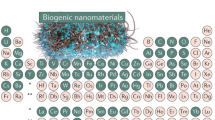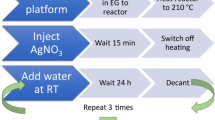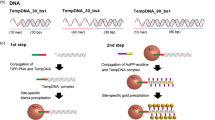Abstract
The creation of nanoscale materials for advanced structures has led to a growing interest in the area of biomineralization. Numerous microorganisms are capable of synthesizing inorganic-based structures1,2. For example, diatoms use amorphous silica as a structural material3, bacteria synthesize magnetite (Fe3O4) particles and form silver nanoparticles4, and yeast cells synthesize cadmium sulphide nanoparticles5. The process of biomineralization and assembly of nanostructured inorganic components into hierarchical structures has led to the development of a variety of approaches that mimic the recognition and nucleation capabilities found in biomolecules for inorganic material synthesis6,7,8,9,10. In this report, we describe the in vitro biosynthesis of silver nanoparticles using silver-binding peptides identified from a combinatorial phage display peptide library.
This is a preview of subscription content, access via your institution
Access options
Subscribe to this journal
Receive 12 print issues and online access
$259.00 per year
only $21.58 per issue
Buy this article
- Purchase on Springer Link
- Instant access to full article PDF
Prices may be subject to local taxes which are calculated during checkout




Similar content being viewed by others
References
Lowenstam, H.A. Minerals formed by organisms. Science 211, 1126–1130 (1981).
Mann, S. Biomineralization: Principles and Concepts in Bioinorganic Materials Chemistry (Oxford Univ. Press, Oxford, 2001).
Cha, J.N. et al. Silicatein filaments and subunits from a marine sponge direct the polymerization of silica and silicones in vitro. Proc. Natl Acad. Sci. USA 96, 361–365 (1999).
Klaus, T., Joerger, R., Olsson, E. & Granqvist, C.G. Silver-based crystalline nanoparticles, microbially fabricated. Proc. Natl Acad. Sci. USA 96, 13611–13614 (1999).
Dameron, C.T. et al. Biosynthesis of cadmium sulphide quantum semiconductor crystallites. Nature 338, 596–597 (1989).
Brown, S., Sarikaya, M. & Johnson, E. A genetic analysis of crystal growth. J. Mol. Biol. 299, 725–735 (2000).
Cha, J.N., Stucky, G.D., Morse, D.E. & Deming, T.J. Biomimetic synthesis of ordered silica structures mediated by block copolypeptides. Nature 403, 289–292 (2000).
Naik, R.R., Brott, L.L., Clarson, S.J. & Stone, M.O. Silica-precipitating peptides isolated from a combinatorial phage display library. J. Nanosci. Nanotech. 2, 95–100 (2002).
Douglas, T. et al. Protein engineering of a viral cage for constrained nanometrials synthesis. Adv. Mater. 14, 415–418 (2002).
Lee, S.-W., Mao, C., Flynn, C.E. & Belcher, A.M. Ordering of quantum dots using genetically engineered viruses. Science 296, 892–895 (2002).
Kroger, N., Deutzmann, R. & Sumper, M. Polycationic peptides from diatom biosilica that direct silica nanosphere formation. Science 286, 1129–1132 (1999).
Aizenberg J., Lambert, G., Addadi, L. & Weiner, S. Stabilization of amorphous calcium carbonate by specialized macromolecules in biological and synthetic precipitates. Adv. Mater. 8, 222–225 (1996).
Brott, L.L. et al. Ultrafast holographic patterning of biocatalytically-formed silica. Nature 413, 291–293 (2001).
Brown, S. Metal-recognition by repeating polypeptides. Nature Biotechnol. 15, 269–272 (1997).
Gaskin, D.J.H., Starck, K. & Vulfson, E.N. Identification of inorganic crystal-specific sequences using phage display combinatorial library of short peptides: A feasibility study. Biotech. Lett. 22, 1211–1216 (2000).
Whaley, S.R., English, D.S., Hu, E.L., Barbara, P.F. & Belcher, A.M. Selection of peptides with semiconductor binding specificity for directed nanocrystal assembly. Nature 405, 665–668 (2000).
Schatz, G.C. & Van Duyne, R.P. Handbook of Vibrational Spectroscopy (eds. Chalmers, J.M. & Griffiths, P.R.) (Wiley, New York, 2002).
Aizenberg J., Lambert, G., Weiner, S. & Addadi, L. Factors involved in the formation of amorphous and crystalline calcium carbonate: a study of an ascidian skeleton. J. Am. Chem. Soc. 124, 32–39 (2001).
Gruen, L.C. Interaction of amino acids with silver ions. Biochim. Biophys. Acta 386, 270–274 (1975).
Kim, E., Xia, Y. & Whitesides, G.M. Polymer microstructures formed by moulding in capillaries. Nature 376, 581–584 (1995).
Delamarche, E., Bernard, A., Schmid, H., Michel, B. & Biebuyck, H. Patterned delivery of immunoglobulins to surfaces using microfludic networks. Science 276, 779–781 (1997).
Weissbuch, I., Addadi, L., Lahav, M. & Leiserowitz, L. Molecular recognition at crystal interfaces. Science 253, 637–645 (1991).
Acknowledgements
This work was supported by funds provided by the Air Force Office of Scientific Research (AFOSR). We thank Rich Vaia and Bob Wheeler for technical assistance.
Author information
Authors and Affiliations
Corresponding author
Ethics declarations
Competing interests
The authors declare no competing financial interests.
Supplementary information
Supplementary Methods
Supplementary Information Table S1 (PDF 319 kb)
Supplementary Information Fig. S1 - S5
Rights and permissions
About this article
Cite this article
Naik, R., Stringer, S., Agarwal, G. et al. Biomimetic synthesis and patterning of silver nanoparticles. Nature Mater 1, 169–172 (2002). https://doi.org/10.1038/nmat758
Received:
Accepted:
Published:
Issue Date:
DOI: https://doi.org/10.1038/nmat758
This article is cited by
-
Colorimetric Detection of Metals Using CdS-NPs Synthesized by an Organic Extract of Aspergillus niger
Applied Biochemistry and Biotechnology (2023)
-
Fabrication of polydopamine-functionalized nanobioconjugates for improved stability and catalytic efficiency towards industrial application
Biomass Conversion and Biorefinery (2023)
-
Effect of hydrophobic groups on adsorption of arginine-based amino acids to solid surfaces in water
Structural Chemistry (2023)
-
Design and sustainable production of natural carbon incorporated CuO/C nanocomposite using Cyperus rotundus biomass
Biomass Conversion and Biorefinery (2023)
-
Adsorption of Lithium on Cell Surface as Nanoparticles through Lithium Binding Peptide Display in Recombinant Escherichia coli
Biotechnology and Bioprocess Engineering (2023)



